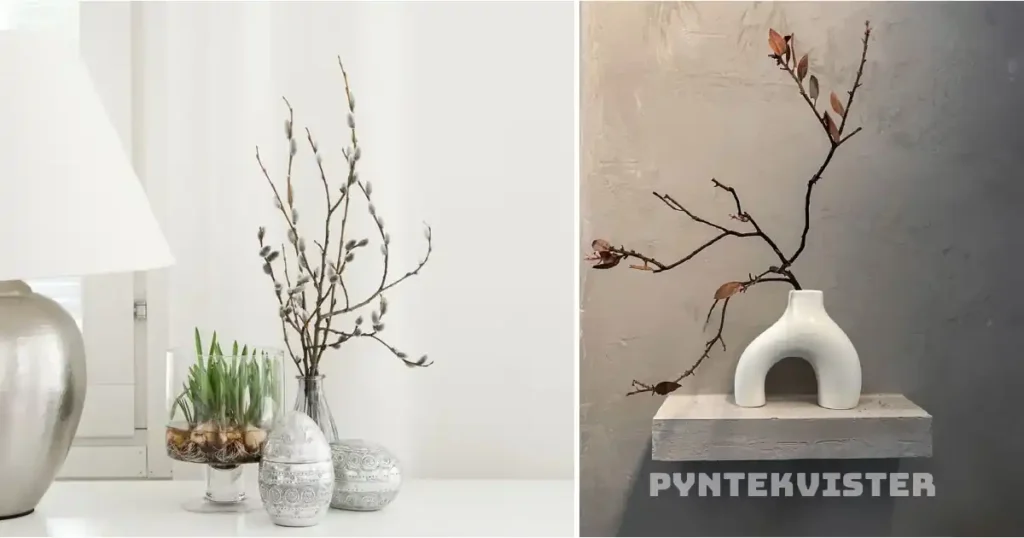Learn pyntekvister, the easy Scandinavian way to add nature to your home. Get DIY tips, trends for 2025, and green ideas for cozy spaces. Simple and fun!
Hey friend, have you ever walked outside and picked up a stick that looked pretty? That’s kind of how pyntekvister starts. It’s a fun way from Norway to make your house feel like the woods are inside. Picture your room with branches that make it calm and happy. Today, let’s talk about pyntekvister like we’re sitting with tea. I’ll show you what it is and how to try it yourself.
What Is Pyntekvister?
Pyntekvister is a Norwegian word for decorative twigs or pretty branches. People use them to make homes look nice with nature bits. It’s like taking a tree part and turning it into art.
These branches come from trees like birch or willow. You put them in vases or hang them up. They add a touch of outside to your inside space.
Think of it as easy decor that doesn’t need much work. Unlike flowers that die fast, pyntekvister lasts longer.
History of Pyntekvister
Long ago in Nordic places, people used branches in special ways. They put them up for luck and to mark seasons. In winter, branches with candles brought light to dark days.
This started in rural spots where nature was close. Branches meant growth and strength. Folks believed birch twigs brought purity to homes.
Over time, it changed from rituals to everyday decor. Now, it’s part of Scandinavian style that loves simple things. Pyntekvister connects us to old stories while fitting modern lives.
Imagine your grandma telling tales of hanging branches for protection. That’s the heart of pyntekvister. It keeps traditions alive in fun ways.
Why Pyntekvister Matters
Pyntekvister brings nature inside, making rooms feel peaceful. In busy city life, these twigs help you relax like a forest walk. They fit biophilic design, which means loving nature in buildings.
Studies show biophilic elements cut stress and boost happy feelings. For example, rooms with natural bits can raise work done by 6% and new ideas by 15%. That’s why more homes use them in 2025.
Compared to fake plants, pyntekvister feels real and changes with time. Fake ones stay the same, but twigs tell stories of seasons. Plus, they’re green – you can pick fallen ones for free, no waste.
Picture a tired day ending in a room with soft branch shadows. Pyntekvister makes that happen. It supports earth-friendly choices too, as 60% of design pros say natural trends rule 2025.
Types of Pyntekvister
There are many kinds of pyntekvister to pick from. Natural ones use plain branches like birch for a clean look. They add warmth without paint.
Painted pyntekvister shine with colors like gold or white. They fit fancy rooms or holidays. Metallic ones add sparkle for modern feels.
LED-lit branches glow softly at night. They’re safe and make cozy spots. Use them for winter fun or party lights.
Twisted designs look like sculptures. Manzanita branches bend naturally for art pieces. Pick what matches your home – simple or bold.
- Natural: Birch or willow for rustic charm.
- Painted: Colors to match your walls.
- LED-lit: For gentle evening light.
- Twisted: Curly shapes for eye-catch.
Each type brings its own magic. Try mixing them for unique looks.
How to Use in Decor
Put pyntekvister in vases for easy table spots. They make great centers that start talks. Add them to shelves for height and interest.
Hang them on walls as art. Tie with string for floating feels. This works well in small rooms to save space.
For events like weddings, use tall branches with lights. They create romantic moods without much cost. Compare to flowers – twigs last longer and cost less.
Try in bedrooms for calm vibes. A branch by the bed helps sleep better with nature touch. Or in kitchens for fresh looks.
Picture a party where guests love your branch setup. It’s simple but wow. Mix with candles for warm glows.
DIY Pyntekvister Tips
Making pyntekvister is fun and easy. Start by finding twigs outside after rain. Clean them with a soft brush.
Paint if you want color. Use spray for even coats. Let dry before using.
Add lights by wrapping strings around. Battery ones are safe and simple.
Steps to make one:
- Pick 5-10 twigs of different sizes.
- Trim ends for flat bottoms.
- Arrange in vase for balance.
- Add bits like ribbons or beads.
- Place where light hits nice.
This saves money compared to buying decor. Forage free twigs instead of store buys. Imagine crafting with kids – they love it.
Fix common issues like loose twigs by tying bases. Or if dull, add glitter for spark.
Seasonal Ideas
Change pyntekvister with seasons for fresh homes. In spring, add buds and pastel ties for new starts.
Summer calls for green leaves and bright paints. Mix with shells for beach feels.
Autumn uses brown twigs with dried leaves. Add pinecones for cozy touches.
Winter shines with white paint and lights. Hang ornaments for holiday joy.
- Spring: Pastel ribbons and eggs.
- Summer: Fresh flowers wrapped on.
- Autumn: Berries and orange tones.
- Winter: Snowflakes and glow lights.
This keeps decor exciting all year. Think of switching monthly like a home calendar.
For parties, match seasons. Spring weddings love budding branches. It beats fake decor by feeling alive.
Care and Trends
Keep pyntekvister nice by dusting gently. Use a soft cloth, no water to avoid rot.
Store in dry spots when not used. Wrap in paper to protect.
In 2025, trends mix pyntekvister with earthy colors like terracotta. Use bamboo vases for green looks.
Smart lights on branches are hot. They fit biophilic trends that calm minds and cut sick days.
Compared to old ways, now it’s more eco with reused bits. This makes homes healthier, as nature decor lowers stress.
Fix fading by repainting yearly. It keeps them fresh for years.
Frequently Asked Questions
What does pyntekvister mean?
Pyntekvister is a Norwegian term for decorative twigs or ornamental branches. It comes from Scandinavian traditions where people use natural branches to beautify homes. These simple elements symbolize nature’s beauty and seasonal changes. In modern use, they add a cozy, eco-friendly touch to any room. You can find them in vases or as wall art for easy style.
How do I start with pyntekvister?
Begin by collecting fallen branches from parks or your yard. Clean them and place in a vase for a basic setup. Add paint or lights to customize. It’s cheap and fun for beginners. Try small projects like table centers first. This way, you bring nature inside without much effort.
Is pyntekvister good for the earth?
Yes, pyntekvister uses natural, fallen branches that are reusable. It reduces waste compared to plastic decor. Foraging supports sustainability by not harming trees. In 2025 trends, it fits biophilic design that promotes green living. Choose local twigs to lower carbon footprints.
What twigs work best?
Birch twigs are smooth and great for minimalist looks. Willow bends easily for curved designs. Hazel offers sturdy shapes. Pick based on your room’s style – light colors for bright spaces. Avoid wet ones to prevent mold. Experiment with mixes for unique arrangements.
Can I use pyntekvister outdoors?
Sure, place them in pots or wreaths outside. Keep in shaded areas to avoid sun fade. Use weather-proof paint for longer life. They’re perfect for patios or gardens. Compared to indoor, outdoor ones might need more care from rain. Try for events like garden parties.
Why is it trendy in 2025?
Pyntekvister matches 2025’s focus on natural materials like rattan and earthy tones. Biophilic trends predict 60% expert influence for calm homes. It boosts productivity by 6% in spaces. With sustainability rising, these twigs offer affordable, green decor options.
Try pyntekvister today for easy, green home fun. Start small and see your space glow!



